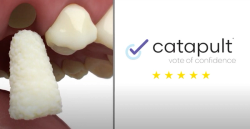- About Us
- Advertise
- Editorial
- Contact Us
- Terms and Conditions
- Privacy Policy
- Do Not Sell My Personal Information
© 2025 MJH Life Sciences™ and Dental Products Report. All rights reserved.
No more guessing
Formulated and manufactured for each component of the waxing process, the InStep casting wax system is designed to ensure that waxes are compatible from blockout to final waxup. This reduces the chance of defects in your castings.
Formulated and manufactured for each component of the waxing process, the InStep casting wax system is designed to ensure that waxes are compatible from blockout to final waxup. This reduces the chance of defects in your castings.
The system contains four different waxes, with melting ranges designed to work with each other. They are: Blockout wax for filling undercuts; Margin wax for accurate margins; Dipping wax with enhanced margin visibility and uniform thickness; and Carving wax for consistent control during buildup and the ability to cut cleanly without stickiness or tackiness.
Following are steps for using the InStep casting wax system.
01 Before applying any wax, mark the preparation margin with a graphite-free pencil. Next apply InStep Blockout wax to the undercuts (Fig. A).
02 Next apply two coats of PDQ Die Spacer. This provides the recommended 24 microns of space to relieve dies (Fig. B).
03 You will then need to paint on a separating agent such as InStep Die Lube. This will keep the wax coping from adhering to the die.
04 Next, hold the die by its dowel pin, and support your hand on the side of the wax pot with your little finger. Then dip the die, turning it quickly (Fig. C). Dip it to just below the prepped margin.
05 Remove the die slowly, continuing to turn it. Hold briefly to let any excess wax drip off.
06 Build up the distal surface using InStep Carving Wax (Fig. D). Its different color provides a nice visual cue when carving. Beige is used when die is going to be scanned.
07 The contours of the buccal and palatal cusps now can be waxed up and shaped and the Dip wax carved away from the margin.
08 InStep Margin Wax is then smoothed into the margin using a heated wax tool (Fig. E).
09 At last, our wax coping is ready to be separated from the die, pattern and sprued (Fig. F) and burned out.
10 Attach the sprue to the thickest portion of the waxup to provide optimum casting results (Fig. G). Fig. H shows the completed waxup.
They work together
The InStep wax system has been formulated with compatible melting ranges designed to burnout “in step,” reducing the chance of costly defects and reworking of your castings. The ranges are: 135°F to 145°F (57°C to 63°C) for the Margin wax; 145°F to 155°F (63° to 68°C) for Carving wax; 170° to 180°F (77°C to 82°C) for Dipping wax; and 200°F to 210°F (93° to 99°C) for Blockout wax. The Quick Start Waxing Kit (Fig. I) makes it possible to try all the waxes without the expense of buying the full-size tins individually.



